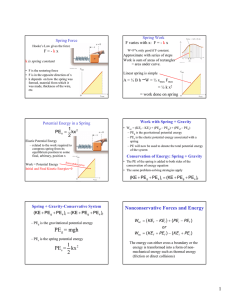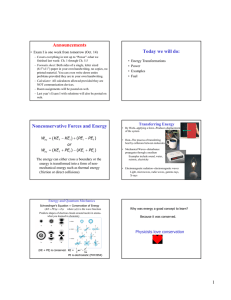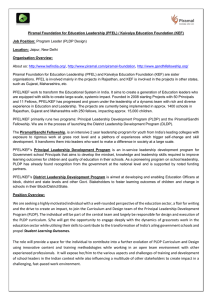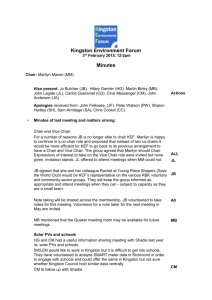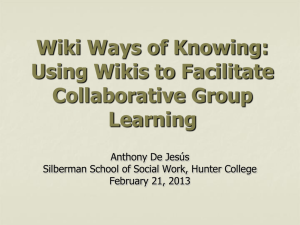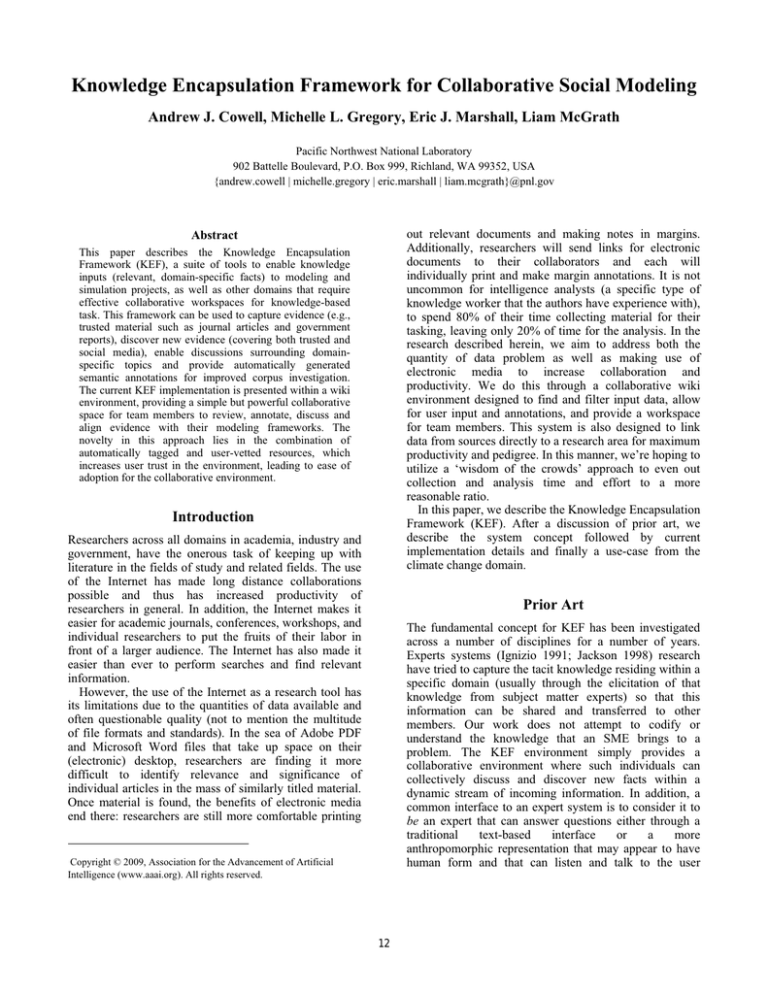
Knowledge Encapsulation Framework for Collaborative Social Modeling
Andrew J. Cowell, Michelle L. Gregory, Eric J. Marshall, Liam McGrath
Pacific Northwest National Laboratory
902 Battelle Boulevard, P.O. Box 999, Richland, WA 99352, USA
{andrew.cowell | michelle.gregory | eric.marshall | liam.mcgrath}@pnl.gov
out relevant documents and making notes in margins.
Additionally, researchers will send links for electronic
documents to their collaborators and each will
individually print and make margin annotations. It is not
uncommon for intelligence analysts (a specific type of
knowledge worker that the authors have experience with),
to spend 80% of their time collecting material for their
tasking, leaving only 20% of time for the analysis. In the
research described herein, we aim to address both the
quantity of data problem as well as making use of
electronic media to increase collaboration and
productivity. We do this through a collaborative wiki
environment designed to find and filter input data, allow
for user input and annotations, and provide a workspace
for team members. This system is also designed to link
data from sources directly to a research area for maximum
productivity and pedigree. In this manner, we’re hoping to
utilize a ‘wisdom of the crowds’ approach to even out
collection and analysis time and effort to a more
reasonable ratio.
In this paper, we describe the Knowledge Encapsulation
Framework (KEF). After a discussion of prior art, we
describe the system concept followed by current
implementation details and finally a use-case from the
climate change domain.
Abstract
This paper describes the Knowledge Encapsulation
Framework (KEF), a suite of tools to enable knowledge
inputs (relevant, domain-specific facts) to modeling and
simulation projects, as well as other domains that require
effective collaborative workspaces for knowledge-based
task. This framework can be used to capture evidence (e.g.,
trusted material such as journal articles and government
reports), discover new evidence (covering both trusted and
social media), enable discussions surrounding domainspecific topics and provide automatically generated
semantic annotations for improved corpus investigation.
The current KEF implementation is presented within a wiki
environment, providing a simple but powerful collaborative
space for team members to review, annotate, discuss and
align evidence with their modeling frameworks. The
novelty in this approach lies in the combination of
automatically tagged and user-vetted resources, which
increases user trust in the environment, leading to ease of
adoption for the collaborative environment.
Introduction
Researchers across all domains in academia, industry and
government, have the onerous task of keeping up with
literature in the fields of study and related fields. The use
of the Internet has made long distance collaborations
possible and thus has increased productivity of
researchers in general. In addition, the Internet makes it
easier for academic journals, conferences, workshops, and
individual researchers to put the fruits of their labor in
front of a larger audience. The Internet has also made it
easier than ever to perform searches and find relevant
information.
However, the use of the Internet as a research tool has
its limitations due to the quantities of data available and
often questionable quality (not to mention the multitude
of file formats and standards). In the sea of Adobe PDF
and Microsoft Word files that take up space on their
(electronic) desktop, researchers are finding it more
difficult to identify relevance and significance of
individual articles in the mass of similarly titled material.
Once material is found, the benefits of electronic media
end there: researchers are still more comfortable printing
Prior Art
The fundamental concept for KEF has been investigated
across a number of disciplines for a number of years.
Experts systems (Ignizio 1991; Jackson 1998) research
have tried to capture the tacit knowledge residing within a
specific domain (usually through the elicitation of that
knowledge from subject matter experts) so that this
information can be shared and transferred to other
members. Our work does not attempt to codify or
understand the knowledge that an SME brings to a
problem. The KEF environment simply provides a
collaborative environment where such individuals can
collectively discuss and discover new facts within a
dynamic stream of incoming information. In addition, a
common interface to an expert system is to consider it to
be an expert that can answer questions either through a
traditional
text-based
interface
or
a
more
anthropomorphic representation that may appear to have
human form and that can listen and talk to the user
Copyright © 2009, Association for the Advancement of Artificial
Intelligence (www.aaai.org). All rights reserved.
12
(Cowell and Stanney 2004). KEF, on the other hand, is
simply an environment that allows for the discussion and
evolution of new knowledge and ideas. There is also often
a significant amount of effort placed in engineering the
knowledge structure in expert systems so that reasoning
can occur to handle unforeseen situations. While KEF
does attempt to annotate semantic relationships identified
within the data sources, these are not hard-coded
ontologies – rather, we build up a categorization scheme
based on the content identified. Finally, typical expert
systems focus on a very narrowly defined domain, such as
Mycin and CADUCEUS (both medical diagnosis
systems), NeteXPERT (network operations automation
system), KnowledgeBench (new product development
applications) and Dipmeter Advisor (oil exploration
system). The concepts set out for KEF can be generalized
for any domain.
Collaborative problem solving environments (CPSE)
are perhaps a better analogy for the concept KEF is
attempting to convey. The Pacific Northwest National
Laboratory has a long history of building CPSE’s for
Department of Energy (DOE) scientists (PNNL 2002),
such as the DOE2000 Electronic Notebook Project
(Myers 1996). Watson (2001) reviewed a number of
organizations pursuing CPSE’s including other DOE sites
(e.g., Common Component Architecture, Collaboratory
Interoperability Framework, Corridor One Project) as
well as the Department of Defense (e.g., Gateway),
NASA (e.g., Intelligent Synthesis Environment (ISE),
Collaborative Engineering Environment (CEE) and
Science Desk) and numerous university efforts (Rutgers
University’s Distributed System for Collaborative
Information Processing and Learning, University of
Michigan’s Space Physics and Aeronomy Research
Collaboratory and Stanford’s Interactive Workspaces).
Shaffer (2006), in his position statement on CPSE’s
defined them as a “system that provides an integrated set
of high level facilities to support groups engaged in
solving problems from a proscribed domain”. These
facilities are most often directly related to the domain,
e.g., facilities to enable 3D molecular visualization for
biologists. KEF includes a number of components but the
focus has always been on the general case – i.e.,
development of capabilities that apply across a number of
domains. Within CPSE’s, there is also significant amount
of effort placed in encouraging synchronous interaction, a
facility provided by KEF through an integrated textual
chat component but secondary to the asynchronous wiki
implementation. Perhaps the most striking difference
between traditional CPSE’s and our implementation of
KEF is the scale of effort. Many of the CPSEs mentioned
above were created over a number of years at the cost of
millions of dollars, and have an excessive learning curve
and setup time. KEF, while leveraging the experiences of
these previous systems, is built using open-source
software (e.g., the same wiki framework used in
Wikipedia1) and is configurable within a few hours.
Perhaps the most similar technology currently available
to KEF are the ‘web 2.0’ information stores available on
the Internet. Examples include encyclopedic resources
such as Wikipedia and Knol2 that rely on ‘wisdom of the
crowds’ to build and maintain a knowledge base of
information. Such resources rarely utilize automated
processes to extract semantic relations and add these as
additional metadata that can aid in the discovery process3.
Like KEF, some of these systems use tags to provide an
informal tagging mechanism but the domain scale are
typically very wide (in the case of Wikipedia, the goal is
to provide an encyclopedia’s worth of knowledge).
Project Halo (Friedland et al. 2004) is specific instance of
an information store that aims to develop an application
capable of answering novel questions and solving
advanced problems in a broad range of scientific
disciplines (e.g., biology, physics, and chemistry). The
mechanism for inserting knowledge into the data store
(i.e., using graduate students with domain knowledge)
requires significant effort. The KEF approach is to share
the load between automated information extraction tools
and domain experts (as see in Figure 1). While we
acknowledge the limitations of automated information
extraction technologies, we believe an approach that
leverages automated means while encouraging users to
make corrections and provide their own annotations may
provide significantly rich metadata.
System Concept & Design
The fundamental concept behind KEF is of an
environment that can act as an assistant to a research
team. By providing some documents (e.g., research
articles from a domain of focus) as an indication of
interest, elements of the KEF environment can
automatically identify new and potentially related
material, inserting this back into the environment for
review. KEF can be configured to harvest information
from individual sites, use search engines as proxies, or
collect material from social media sites such as blogs,
wikis, and forums etc. Harvesting strategies include:
x simple metadata extraction (e.g., author and co-author,
material source (e.g., journal name), citations within
original documents, etc)
x topic identification (e.g., climate-change, food supply,
access to education, etc)
x sentiment analysis (e.g., the fact that the statements
related to climate-change are positive or negative)
1
http://www.wikipedia.org
http://knol.google.com
Although a new effort entitled DBpedia (http://dbpedia.org) is a
community effort to extract structured information from Wikipedia.
2
3
13
x rhetorical analysis (e.g., identification of issues being
relayed from a protagonist to a target audience with a
specific intent to cause an effect).
Initial results may lack close relevance due to the
general criteria for search. Users can vet the material
collected, either by single items or by groups (e.g.,
everything from a particular author or journal). This
procedure serves as input to the harvesting strategy until a
tightly defined harvesting strategy matches exactly with
what the research team needs. Eventually, the research
team can expect to receive a steady stream of relevant
traditional material and social media. Documents collected in this first phase are used as part
of the discovery phase. The documents are ‘virtually’
dissected by a number of KEF components (i.e.,
automated software tools) in order to understand their
constituents and relevance. Based on these elements, new
material (e.g., documents, websites, blogs, forums, news
articles, etc) are discovered and pushed through an
extraction pipeline prior to being ingested into the
knowledge base. This process is cyclic, altered by the
feedback provided by the user during the vetting/review
phase.
As material is introduced to the knowledge base, it can
be reviewed by the users through the KEF wiki. The wiki
provides a simple but powerful collaborative environment
for the vetting, evaluation and alignment of evidence to
models. Each of these phases is described in more detail
in the following sections.
Phase 1: Knowledge Elicitation
Figure 1. The KEF Shared Effort Concept
As the data repository is populated with relevant
material, users can interact with the data on a variety of
levels depending on their goals. All data in the repository
is automatically tagged with basic document metadata
(source, author, date, etc.), as well as with semantic
information extracted from the text during the ingestion
routine. Using information extraction tools, all entities
(people, locations, events, etc.) in the text are marked and
user-identified key terms are automatically tagged (e.g.,
climate terms in the case of a climate modeling scenario).
These tags provide a means of search and organization
that provide for ease of recall. Importantly, users can
correct existing annotations, or create their own to match
their individual needs. Users can replace manual margin
mark-up with notes or annotations that can be searched on
later or used by other collaborators. Finally, each
document has a talk page where users can discuss
(asynchronously) the document. A synchronous ‘chat’
component is also available.
Figure 2. The KEF Process
In order to initiate the automatic harvest-user vetting
cycle, we need an understanding of the intended users’
domains. The extraction of expert knowledge so that it
can be actively utilized by non-experts (in this case, an
automated system) has been the focus of a number of high
profile research projects. Perhaps the most widely known
of these efforts was the DARPA Rapid Knowledge
Formation (RKF) Program that attempted to enable
distributed teams of users to enter and modify knowledge
directly without the need for specialized training in
knowledge representation, acquisition, or manipulation.
A more recent ancestor of the RKF program was
mentioned earlier - Project Halo (Friedland et al. 2004),
an ambitious endeavor that aims to develop an application
capable of answering novel questions and solving
advanced problems in a broad range of scientific
disciplines. Some elements of Project Halo are already
being reused within the KEF repository (e.g., the
mediawiki engine with semantic extensions). While many
types of knowledge elicitation techniques exist (Burge
The Process
From a users perspective, the KEF process is illustrated in
Figure 2. Knowledge elicitation experts meet with
modelers and subject-matter experts4 to get an
understanding of their problem. For example, in the case
of a modeling group trying to understand the effects of
climate change on the Indian sub-continent, this may lead
to the creation of a context map showing all the elements
of climate change that may apply (e.g., access to
education, clean water, etc) and a selection of documents
currently used to create and parameterize their models.
4
Depending on the domain, these may be the same person.
14
2005), in KEF we rely on structured interviewing
(Hudlicka 1997) with case study discussions directly
related to the selected domains (Geiwitz et al. 1990). We
have also investigated the use of concept mapping
(Thordsen 1991; Gowin and Novak 1984) as part of the
structured interviews in order to gather a graphical
representation of the scenario.
In addition to structured interviews, users are asked to
provide a list of trusted sources (e.g., specific journal
articles, government reports, etc) that they rely on for
building and/or parameterizing their models. In some
cases this may result in large amounts of printed matter
that that needs to be ingested into the framework using an
optical character recognition (OCR) workflow. These
trusted sources initiate the automatic discovery process
(Figure 3).
Phase 3 & 4: Reviewing/Aligning Material
While wiki’s are generally repositories of information,
albeit dynamically generated through the interaction of
multiple users, one key element of this framework is the
interactive manipulation of knowledge within the
environment. As the discovery process identifies new
material, the environment leads the user through a fourstage analysis; review, relevance, evaluation and task
alignment. These stages can be viewed in Figure 4.
Phase 2: The Discovery Process
Figure 4. The KEF Review Process
1. Review We use multiple automated methods to
describe the new content including statistics (e.g., 40% of
new material came from blogs), simple easy-tounderstand graphic visualizations (e.g., pie and bar chart
representations, as well as more complex clustering
representations) and material summaries. The aim is to
provide enough context so that the user can decide on
material relevance without having to read the entire
document (although a link to the complete text is
provided, should the user require it).
2. Relevance For each piece of evidence, the user is
required to make a judgment regarding its relevance to
their current domain. We provide three alternatives: ‘Yes’
(the document is directly relevant to my problem), ‘No’
(the document is irrelevant to my problem) and ‘Don’t
Know’. A ‘Don’t Know’ response might be due to the
individual not having the expertise to make that decision
(e.g., it is outside their domain) or simply due to them not
having time to make the decision. Any response removes
the item from their work list although it remains within
the lists for their colleagues in order to capture multiple
opinions. Material that receives a large number of
irrelevant votes is moved to an archival namespace and is
no longer included in system statistics (although it can
still be retrieved by users if they wish).
Figure 3. The KEF Discovery Process
In order to isolate relevant parts of information from our
user-supplied sources, we have employed a number of
automated information extraction tools. These tools
provide a search template that directs the discovery
process (for example, extracted topics from the usersupplied sources that are then used in conjunction with
document metadata to return new, potentially relevant
documents). In addition, the same components are used to
annotate the new material to provide multiple levels of
summary and visualization through the vetting process.
The new documents are placed directly into the KEF
knowledge base, but tagged to show their unvetted status.
They are user-accessible through the KEF wiki, with each
document representing a page in the wiki.
3. Evaluation A response of ‘Yes’ leads the user through
two more dialogs. In the evaluation stage, the user rates
the document importance (valence/strength) with respect
to their task and the document credibility (i.e., a
subjective measure of trust in the document contents). We
15
aaim to use theese ratings in a recommenddation contextt
(‘users similar to yourself also liked…’) annd for trainingg
s
For cerrtain modelingg systems (e.g.,
thhe discovery system.
B
Bayesian
analyysis), these raatings may alsso be used too
d
define
node streength.
p
page with
w a number of
o access pointts to access
of a project
inforrmation (e.g.,, through a timeline (F
Figure 6),
geoggraphically aliggned (Figure 7)) or in a table (F
Figure 8)).
Thhe automated innformation exttraction pipelinne consists
of thhree main com
mponents: a nam
med entity reccognizer, a
summ
marizer, and a geo-referencee component. The
T named
9
entityy recognizer (NER) is baased on the Connexor
softw
ware that idenntifies proper names, selectss common
nounns and maps them to semanticc tags via theirr identified
1
10
categgories. Conneexor Metadata is used to iddentify the
namees, their categories and their lemmatized form. The
summ
marizer compoonent, based on
o the publiclyy available
11
MEA
AD summarizeer , creates a summary
s
of onne or more
pages of a sourcee document by
b identifying the most
signiificant sentencees. It is used in the pipeline to create
‘sum
mmary’ propertiies for single-ddocument pagees. Finally,
the geo-reference
g
component prrovides a mapp view of
sourcce documents based
b
on NER locations. Loccations are
44. Task Align
nment After ev
valuating the document, thee
f
final
stage alllows the userr to align thee data to anyy
s
structure
relevaant to their task
k. In the case of
o a model, thee
u
user
may alignn the material directly to a specific
s
modell
innput. For otherr applications, this may be a simple sortingg
m
mechanism
foor further intterpretation. Concept
C
mapss
g
generated
in thhe first phasee might providde a sufficientt
m
mechanism
for alignment.
Teechnical Imp
plementatioon
Figurre 6. The Timelinne View
F
Figure
5. Accesss Points to Revieew Material
The current im
T
mplementation is based on a Mediawiki5
innstallation. Meediawiki is arg
guably the moost well knownn
o the current generation
of
g
of wiki
w engines annd is the enginee
u
used
in both Wikipedia6 an
nd Intelipediaa7. Due to itss
p
popularity,
a nuumber of third
d-party extensiions have beenn
d
developed,
andd, where possib
ble, we have leeveraged thesee
too provide a more
m
effective environment. For example,
innstead of impplementing ourr own semantiic layer wheree
r
relationships
can be defined
d within docum
ment elementss
(e.g., Paul is_thhe_author_of Document-X),
D
, we employedd
M
(SM
MW8) extensionn.
thhe Semantic Mediawiki
A number off access viewss are used to enable
e
users too
innteract with thhe information in the repositoory using theirr
p
preferred
mechhanism. For ex
xample, Figuree 5 shows partt
Figurre 7. The Geograaphic View
5
http://www.mediaawiki.org
http://www.wikippedia.org
7
http://en.wikipediia.org/wiki/Intellip
pedia
8
http://www.semanntic-mediawiki.org
g
ǣȀȀǤ
Ǥ
Ȁ
httpp://www.connexor..eu/technology/maachinese/
11
httpp://www.summarizzation.com/mead/
6
ͻ
10
16
F
Figure
8. The Taabular View
cchecked againsst the Google Geocoding
G
Servvice12 to createe
a set of coordinnates associateed with an articcle. For pagess
w
with
many location names,, these coorddinates can bee
r
restricted
to thoose that occur most frequenttly, or those inn
thhe summary or
o title of the page to highhlight the mostt
r
relevant
locatiions. After a set of pagges has beenn
p
processed,
a neew page is creaated with the map
m view usingg
thhe Google Maaps MediaWiki extension. Thhis componentt
c
creates
a ‘Geoggraphically Aliigned View’ paage in the wikii
(as shown abovve in Figure 7)..
Finally, to provide
p
a com
mpelling user experience,
e
wee
im
mplemented a custom version of the Project
P
Halo133
e
extension.
This allows the user
u
to adjustt the semanticc
m
markup
made by
b the automated discovery mechanism
m
andd
a make theirr own annotatio
also
ons.
Figure 9 show
ws how a docu
ument may apppear within thee
r
repository.
Thee citation and
d an offline veersion (in thiss
e
example,
an Addobe PDF file)) are shown att the top of thee
p
page,
with an ‘infobox’ sho
owing the jourrnal the paperr
c
came
from andd other metadaata (e.g., authorr, date, etc). A
liink is maintained to the oriiginal source URL.
U
The textt
w
within
the pagee can not be alltered althoughh users can addd
thheir annotationns (Figure 10) and review the automatedd
a manual annnotations (Figu
and
ure 11).
Figurre 9. A Journal Article
A
Figurre 10. Annotatingg Text in the Wikki
122
133
http://code.googlle.com/apis/maps/d
documentation/serrvices.html
http://semanticweb.org/wiki/Projecct_Halo
17
w
the
thee new materiaal geographicaally aligned with
loccations mentiooned in the artiicles, and also as a tag
clooud with mosst common teerms appearingg larger
thaan those of lesss importance. A timeline viiew also
preesents all 42 articles in publication ordder. She
nootices both ‘Food’ and ‘India/Indian’ appear
proominently inn the cloud.. She restricts the
geeographical viisualization too reports menntioning
Inddia, and then clicks ‘Food’ in the tag clooud. The
tabble refreshes too only show 5 articles.
a
L clicks on the first andd is provided with a
Liz
summary of thhe article. It appears to be
b only
tanngentially relatted, so she rejeects it and movves on to
thee next article. This one appeears to be mucch more
intteresting. Afteer reading the summary, Liiz clicks
thee link to see thhe full article, as
a presented within the
wiiki. The page opens and thee ‘infobox’ in the top
rigght hand corneer displays sum
mmary detailss. Terms
exxtracted from the documennt are shown at the
boottom of the article (such as PLACES
S: India,
Paakistan and PE
EOPLE: John Smith). This provides
p
annother type of summary for Liz to get an idea of
hoow useful the article
a
might be
b without readding line
byy line. She is interested,
i
how
wever, and choooses to
revview the entiree article. She even
e
fixes a coouple of
errrors made by thhe automated annotation
a
systtem.
T
There
is one specific paraagraph and taable that
reffers directly too her problem
m domain. It describes
d
croop estimates foor the differentt regions in Inndia. She
annnotates this byy attaching the FOOD properrty tag to
thee paragraph annd table. She notes,
n
howeverr, that it
dooes not match estimates madde by another research
artticle. She annootates the articlle and the com
mparative
artticle to show the differences. She may seend both
artticles to Cesarr (her colleaguue) or anotherr project
teaam member to help determinne which estim
mates are
moore “trusted.” Or she may liink the annotaations so
thaat the model may use eitheer or a range derived
froom both.
A
After
reviewinng the rest of thhe articles and the new
bloog that was identified by KEF (narrow
wing the
seaarch parameters for the blogg so that onlyy articles
rellating to India, Pakistan, and Bangladdesh are
haarvested), Liz moves throuugh into herr vetted
maaterials space. This page describess those
doocuments, articcles and miscelllaneous notes that she
haas collected thaat are importannt to her modell. In this
space, Liz can write notes, make
m
annotations and
l
betweeen the materrial and
staart to make linkages
specific elements of her modell. She can alsoo start to
maake assessmennts of the strrength, relevannce and
creedibility of the material (e.gg., a particulaar article
miight be very relevant
r
to a particular
p
model node,
annd be strongly supporting onn side of the argument
buut come from a source that isnn't very crediblle).
S
She
notices that
t
Cesar haad added som
me new
maaterial to the Governance node. She is able to
revview the particcular piece of the governmennt report
F
Figure
11. The Annotations
A
for a Journal Articlee
Use Case
C
To illustrate thee process from
T
m a user perspeective, we havee
b
built
a use case describing th
he environmennt applied to a
C
Climate
Channge & Securrity scenario. Not all thee
f
functionality
d
described
in the use caase has beenn
im
mplemented at
a this time; however, it serves as ann
e
effective
visionn for what KE
EF could potenntially providee
k
knowledge-wor
rkers in the neaar future.
Liz, the lead for the 'Vulnerabilitty of Food
nfrastructures to Climate
Security annd Energy In
Change and Terrorism' prroject, opens her
h browser
window andd selects a bookmark for the Knowledge
Encapsulatioon Framework Wiki. Liz runns her cursor
down the navvigation menu and selects herr project.
On clickinng the link, Liz
L is presenteed with her
project’s hom
mepage on the wiki. In the topp right-hand
corner some usage statisticcs are shown. She notices
y
at
that her graaduate studentt logged on yesterday
4.23pm. Shee can see what he did and tasks
t
he has
prepared for her. The main
n section of thee page holds
details on neew material thaat has arrived since she last
logged on too her project wiki. Today, it appears a
new blog hass been detected
d that might bee of interest.
There are also 32 blog artticles and 10 news
n
articles
h previouslyy defined as
related to concepts Liz has
B
this spacce is an area thhat describes
important. Below
the current sttate of her mod
deling effort. This
T includes
a concept maap of the main components of her model,
and importaant terms (eitther selected by Liz or
suggested byy the system and
a accepted by
b Liz). She
feels the moodel is specificcally weak on information
related to foood supply in In
ndia.
She movess her cursor to the 'new item
ms' space and
clicks 'exploore'. This takes her to a new
w page that
lists the new
w items in a tab
bular form. Shee requests to
see the new material graph
hically. The wiki
w presents
18
he annotated. She makes an assessment of the
strength and credibility of the document that is
significantly lower than those Cesar placed, as she
knows the author and remembers he has a tendency
to over-estimate. She clicks on his name (which
creates a new wiki page specifically for this author)
and writes a quick note to explain why. She then
reviews her “notes and questions” space, adds
several comments and a question to it.
Time is getting on and Liz needs to get on the road
to avoid the afternoon traffic. She logs off the wiki,
retrieves a printed article from the printer, and makes
for the door....
for Human Computer Interaction, Worcester Polytechnic
Institute.
Pearl, J. 1988. Probabilistic Reasoning in Intelligent
Systems, San Fransisco, CA: Morgan Kaufmann.
Purvis, N. and J. Busby. 2004. The Security
Implications of Climate Change for the United Nations
System. ECSP Report, Issue 10.
Schafer, G. 1976. A Mathematical Theory of Evidence.
Princeton, NJ: Princeton University Press.
Schum, D.A. 2001. The Evidential Foundations of
Probabilistic Reasoning. Evanston, IL: Northwestern
University Press.
Conclusion
We have presented a collaborative workspace for
researchers to gather, annotate and store relevant
information. The combination of automatically harvested
material with user vetting helps the researcher effectively
handle the potentially large quantities of data available,
while providing a measure of quality control.
The use of a semantic wiki allows multiple people to
add, vet and discuss source material, enabling effective
collaboration. The co-location of source material, user
annotation and discussions provides for effective
collection of provenance.
Select Committee on Intelligence. 2004. Report on the
U.S. Intelligence Community's Prewar Intelligence
Assessments on Iraq. Washington, D.C. United States
Congress.
Acknowledgements
Jackson, P. 1998. Introduction to Expert Systems (3rd
Edition). Addison Wesley.
Thordsen, M. 1991. A Comparison of Two Tools for
Cognitive Task Analysis: Concept Mapping and the
Critical Decision Method. In Proceedings of the Human
Factors Society 35th Annual Meeting, 283-285.
Ignizio, J.P. 1991. Introduction to Expert Systems: The
Development and Implementation of Rule-Based Expert
Systems, McGraw-Hill.
The authors would like to acknowledge the support and
feedback of the Technosocial Predictive Analytics
Initiative at the Pacific Northwest National Laboratory as
well as the reviewers and editors that have helped refine
this paper and the associated research.
PNNL.
2002.
Collaborative
Problem
Solving
Environments.
Available
from
http://www.pnl.gov/cpse/whatwedo.stm.
Accessed
September 22nd, 2008.
Shaffer, C.A. 2006. Collaborative Problem Solving
Environments.
Available
from
http://people.cs.vt.edu/~shaffer/Papers/DICPMShaffer.ht
ml. Accessed October 2nd, 2008.
References
Besancon, R., M. Rajman, et al. 1999. Textual
similarities based on a distributional approach. Database
and Expert Systems Applications, Florence, Italy, IEEE.
Myers, J.D. et al. 1996. Electronic Laboratory Notebooks
for Collaborative Research. In Proceedings of WETICE
’96. Stanford University, June 19-21, 1996. IEEE
Computer Society, 47-51.
Geiwitz, J., Kornell, J., McCloskey, B. 1990. An Expert
System for the Selection of Knowledge Acquisition
Techniques. Technical Report 785-2, Contract No.
DAAB07-89-C-A044. California, Anacapa Sciences.
Watson, V.R. 2001. Supporting Scientific Analysis within
Collaborative Problem Solving Environments. In HICSS34 Minitrack on Collaborative Problem Solving
Environments, Maui, Hawaii, January 3-6, 2001.
Gowin, R., Novak, J.D. 1984. Learning how to learn.
NY: Cambridge University Press.
Hammouda, K. M., Kamel, M.S. 2004. Document
Similarity Using a Phrase Indexing Graph. Knowledge
and Information Systems 6(6): 710-727.
Cowell, A.J., Stanney, K. 2004. Manipulation of Non
Verbal Interaction Style and Demographic Embodiment
to Increase Anthropomorphic Computer Character
Credibility. International Journal of Human-Computer
Studies, 62(2) : 281-306.
Hudlicka, E. 1997. Summary of Knowledge Elicitation
Techniques for Requirements Analysis, Course Material
19


